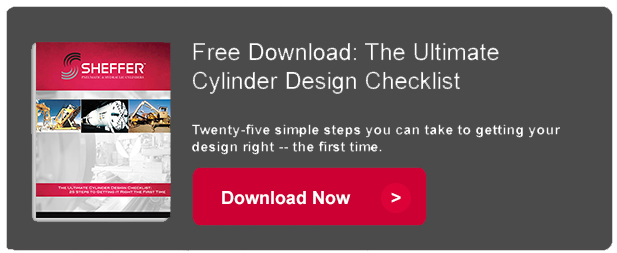 When installed with proper alignment, fluid power cylinders will provide the smooth trouble free performance for which they were intended. Unfortunately, perfect alignment is extremely difficult, if not next to impossible to achieve. During cylinder operation, any misalignment can impose an eccentric force on the piston rod known as “side loading”.
When installed with proper alignment, fluid power cylinders will provide the smooth trouble free performance for which they were intended. Unfortunately, perfect alignment is extremely difficult, if not next to impossible to achieve. During cylinder operation, any misalignment can impose an eccentric force on the piston rod known as “side loading”.
Side loading can conceivably be the most common cause of premature cylinder failure. A side load of sufficient magnitude can result in tube scoring, piston rod and rod bearing wear, and seal failure, individually or in combination. Yikes.
Fortunately, there are some considerations during the cylinder selection process that can compensate for less than proper cylinder alignment:
- Selecting a cylinder mount
- Rod size and column loading
- Stop tube/dual piston
- Miscellaneous options
1. Selecting a Cylinder Mount
Cylinder mounting is governed by the scope of the application. All N.F.P.A. mounting styles (as well as those which are not N.F.P.A. recognized) fall into three categories:
- Mounts where the line of force is along the cylinder centerline. This includes flange mounts, tie rod mounts, and centerline lug mounts. These mounts are better suited to tolerate misalignment and minimize side loading during cylinder operation.
- Mounts where the line of force is along the cylinder centerline and the cylinder is allowed to articulate in a curved path. Clevis, pivot, and trunnions are inclusive of these types of mounts. Although the line of force is along the cylinder centerline, the curved path of the cylinder travel can induce off-center forces and, thus, produce a side load.
- Mounts where the line of force is along the cylinder centerline but the mount is offset to the side or edge of the cylinder. This type of mount includes side lugs, end lugs, tapped holes, and foot brackets. With the mount being offset from the line of force, a moment is generated that wants to rotate the cylinder around its mounting bolts. This moment is quite capable of creating a side load.
Dealing with multiple mountings? How fun! Check out Multiple Mountings: Magic or Misery?
2. Selecting a Piston Rod Size
Selecting the proper piston rod size for a cylinder is the second factor to consider to minimize side loading. Resistance to bending, sagging, buckling, and acceptable bearing loads all contribute to reducing side loading and all can be attained with the selection of the proper rod size.
3. Stop Tube/Dual Piston
The third factor in addressing side loading is the use of stop tubes or dual pistons. Stop tubes provide additional support for extended piston rods and increase the bearing separation between the rod bearing and the piston. They reduce bearing stress and can prevent “jack-knifing”, both of which are contributory to side loading.
Dual pistons accomplish the same as stop tubes, however, they offer additional bearing surface to combat more severe side loading.
4. Miscellaneous Options
There are some additional options that can be employed to further help in reducing side loading: increased bearing lengths, higher strength bearing materials, rod aligning couplers, and spherical bearings can all be considered if design latitude allows.
In any case without precise alignment, cylinder side loading can be generated and cause premature cylinder failure. Minimizing this side loading can be accomplished with attention to the proper selection of cylinder mount, rod size, and whether or not a stop tube or dual piston is required. Rod bearing modifications and rod end attachments should also be examined. Addressing these various factors at the onset of the design process can enhance cylinder installation and application, minimize side loading, and achieve the best possible cylinder reliability and service life.
What other ways have you found or would you explore in addressing the issue of sideloading? Leave a comment with your thoughts below...

